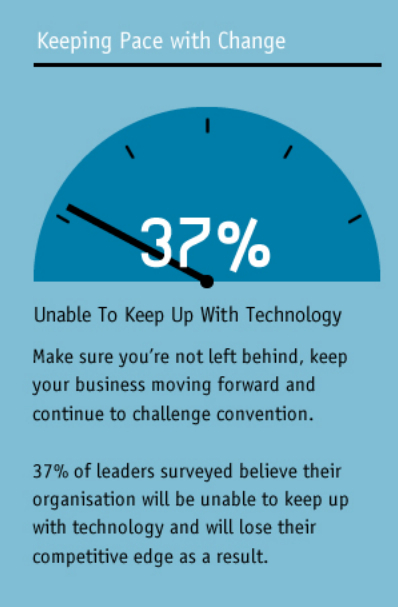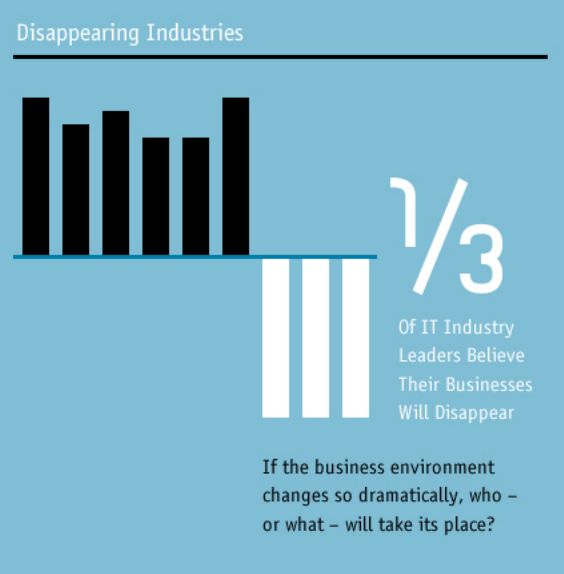Wayne Gretzky is by most accounts the greatest hockey player ever. His father gave him a piece of advice that has been almost immortalized in business circles over the past several years.
“Go to where the puck is going, not where it has been.”
So, where will the puck be 8 years from now? I’d be foolish if I thought I could tell you exactly, but there are an ever increasing number of data points that we can leverage to collectively map our corporate strategies. Highlights from one such data point is below.
The Economist Intelligence Unit, in a study sponsored by RICOH, surveyed 567 senior executives across industries in late 2011 on their expectations of the impact that technology will have on business between now and 2020.
The survey results highlight the reality that the general consensus amongst senior business leaders is that our future is more uncertain and up for grabs than it has been for most of the last century.
Not only do 37% of leaders surveyed believe that they won’t be able to keep up with the pace of change, but 1/3 of IT industry leaders believe their business will actually disappear in the next 8 years.
Flattening and Widening
62% of Business Leaders expect decentralization of key business functions, and most expect that customers will be the primary source of new product and service ideas, switching relatively rapidly from today’s R&D departments.
The digitization of everything is flattening out organizational structures, even beyond corporate walls. More participants are contributing to corporate efforts than ever before in roles that are still in the process of being defined, or haven’t quite yet been invented.
All images above were taken from the “How will you work in the future?” infographic.
The concepts of open innovation, crowdsourcing, and collective intelligence are growing as businesses try and leverage the collective wisdom of the crowd to compete in ever shortening business cycles.
Instead of the heavy investment in developing and retaining capabilities, a networked world provides the ability to tap “capabilities on demand” from individuals and partners. The construction of new ecosystems, networks, and flows for information, goods, and services marks the biggest challenge for business leaders for this next decade.
Perhaps one of the most interesting predictions of the study is that Mid-Size companies will be less common in 2020. From the Executive Summary:
“Mid-size companies will be less common in 2020, not least as micro-entrepreneurs proliferate. Technology advances will support a rise in micro-entrepreneurs in the decade ahead, and will enable these tiny businesses to act like far larger ones. This has direct implications for mid-size companies, which will increasingly need to choose whether to become larger to compete on scale, or smaller to compete on speed. Many will face this decision in the years ahead.”
While I generally agree with the assessment, I believe that yet a third opportunity exists, and that is for mid-size companies to potentially morph into integrated networks of smaller companies. Whether these smaller companies are separated at the entity level or not, evolving into platforms that enable integrated and dynamic value chains may be a compelling third option for today’s mid-sized organizations.
Smaller units will increasingly have the ability to leverage units of capability from complimentary goods and service providers and create value for their stakeholders accordingly.
Questions to consider
Given your vantage point, do you agree with the executives surveyed for the study?
What steps are you taking to adjust to a world where innovation cycles are shorter and more dynamic, customers are more empowered, and more of our (corporate and individual) actions are digitized and measured?
How will you balance the pressurs of executing to meet today’s requirements while preparing for an environment that might look significantly different than today’s?
|
|
This post was written as part of the IBM for Midsize Business program, which provides midsize businesses with the tools, expertise and solutions they need to become engines of a smarter planet. |





Interesting article – aimed at mid-sized businesses RT @BrianVellmure: Your org 8 years from now http://t.co/IYUxeDVB #socbiz
Your organization 8 years from now: http://t.co/g57OO6oW
How do a middle manager get risk adverse top management to make long term plans. Since the future is unknown top management worries that any decision could be wrong. So, all decisions are usually reactive rather than proactive
Rick, what you describe is very common. Hopefully articles like this can serve as data points to help thaw the paralysis. No decision is still a decision, and it is one that likely leads to a slow and gradual death with plenty of excuses in the post-mortem.
What to do? Seth Godin’s Linchpin comes to mind. Take a peek if you haven’t already.
Educate yourself and begin to evangelize internally. In a more democratized world, you have both the opportunity and the challenge of making an impact (both within your current organization and externally). Earn the right to have an audience with senior management. Make a compelling case for what should change and the implications of making the change (or not).
Thanks for stopping by. Feel free to reach out if you’d like to chat more.
1/3 of IT industry leaders predict their businesses will disappear during the next 8 years. http://t.co/5boFToHD
1/3 of IT industry leaders predict their businesses will disappear during the next 8 years. http://t.co/5boFToHD